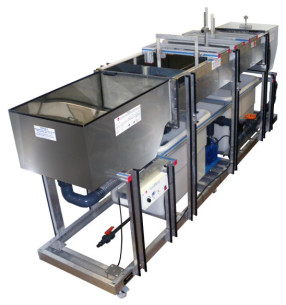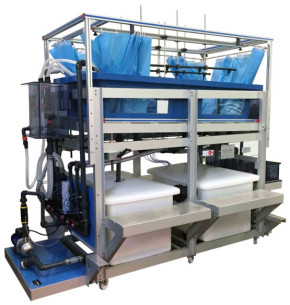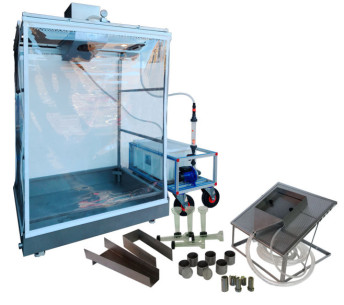HVFLM-4 Mobile Bed and Flow Visualization Unit (working section: 4000x610 mm)
INNOVATIVE SYSTEMS
The Mobile Bed and Flow Visualization Unit (working section: 4000x610 mm), "HVFLM-4", is a particularly useful equipment to demonstrate the fluidization phenomenon in engineering.
Laboratories
RELATED NEWS
General Description
The Mobile Bed and Flow Visualization Unit (working section: 4000 x 610 mm), "HVFLM-4", may be used mainly in two study fields. The first one is the investigation of mobile beds, which are related to water courses and civil engineering structures. The second one is related to the visualization of the flow in two dimensions.
The HVFLM-4 unit consists of an horizontal channel through which a current of water flows slowly and at a constant depth. This channel allows to visualize the flow and the mobile bed in two dimensions as it has a large working surface (section: 4000 mm x 610 mmm). The upper part of this surface can be completely visualized during the practical exercises, without the need of assembling any accessory.
The position of different models and structures in the channel, where the flow circulates around them, allows to carry out studies of mobile bed and flow visualization in a simple way.
The unit is self-contained and it consists of an inlet tank with adjustable overshot, a channel with sand traps, a discharge tank, water storage tanks, a centrifugal pump, an electromagnetic flow meter and set of models. The unit includes the necessary instrumentation to measure the water level and the bed depth, formed by an instruments carrier and a gauge.
The practical exercises with this unit are carried out by using water and sand.
Exercises and guided practices
GUIDED PRACTICAL EXERCISES INCLUDED IN THE MANUAL
- Observation of the flow around model engineering structures.
- Mobile bed experiments.
- Study of the meandering water courses characteristics.
- Visualization of the behaviour of boundary layers.
- Demonstration of boundary layer suction.
- Studies of erosion.
- Studies of deposition.
- Studies of velocity distribution in duct flow.
- Studies with engineering structures.
- Two dimensional flow visualization.
- Study of the hydraulic analogy to compressible flow.
SIMILAR UNITS AVAILABLE
SUPPLEMENTARY EQUIPMENT
Computer Controlled Hydrologic Systems, Rain Simulator and Irrigation Systems Unit (4x2 m)
Computer Controlled Hydrologic Systems, Rain Simulator and Irrigation Systems Unit (2x1 m)
Hydrologic Systems, Rain Simulator and Irrigation Systems Unit (2x1 m)
Computer Controlled Hydrologic Studies Unit
Hydrologic Studies Unit
Rainfall Hydrographs Unit
Computer Controlled Rainfall Simulator for Soil Erosion Studies
Rainfall Simulator for Soil Erosion Studies
River Flow Simulator
Mobile Bed and Flow Visualization Unit (working section: 2000X610 mm)
Sediment Transport Demonstration Channel
Sediment Transport Unit
Quality

AFTER-SALES SERVICE

 Cookie preferences
Cookie preferences



















